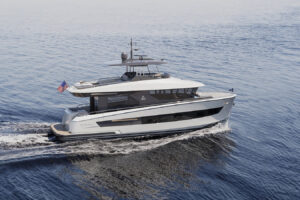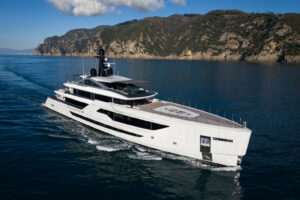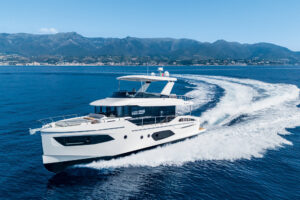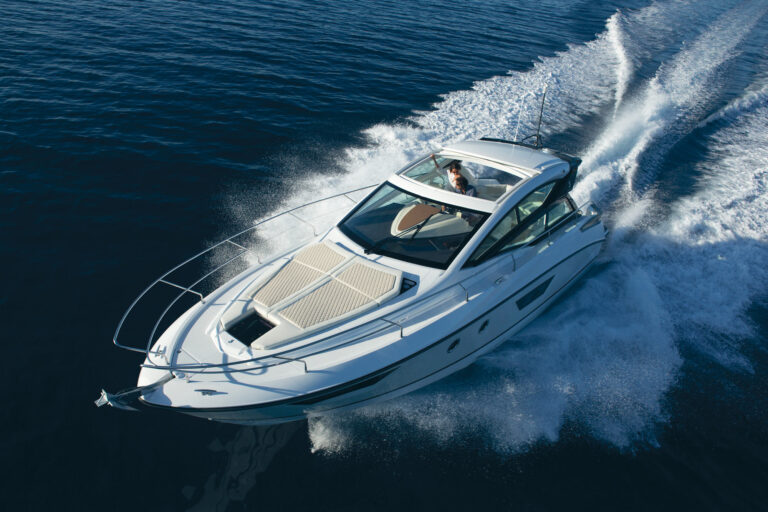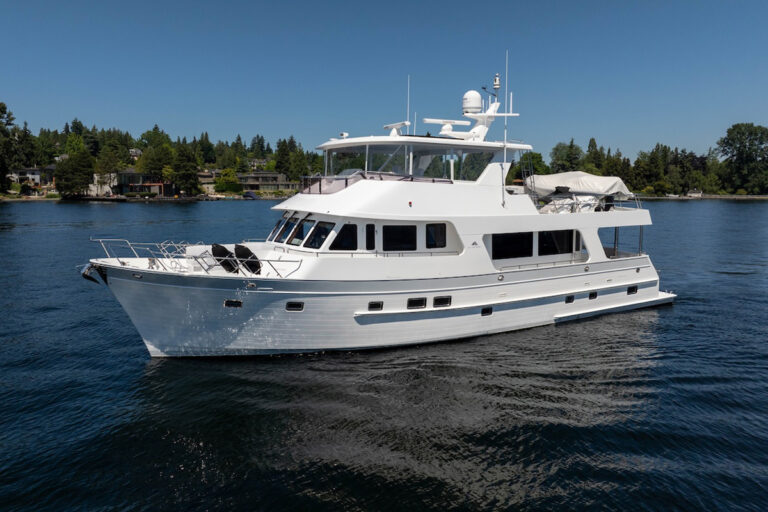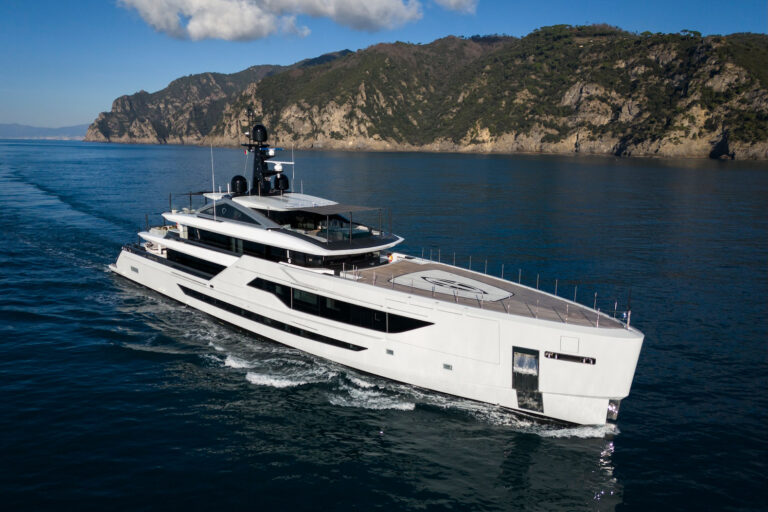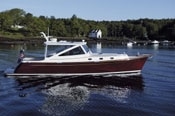
SHEER SUITE: With lines like these, the 38 ought to make hearts skip a beat.
Experience doesn’t always prepare you for close encounters of the nautical kind. I’ve known this for a long time, but these encounters never fail to surprise me. Annie Rose is a perfect example of what I’m talking about. Photographer Billy Black and I had made a date to meet Chip Williams and his new Lyman-Morse 38 Jet at seven in the morning. He’d wait for us on the boat, moored a stone’s throw off his property on the western side of Pemaquid Point, in Maine. Billy and I cast off under a brightening sky and less than 10 knots of wind, figuring to take about 45 minutes aboard Billy’s borrowed Corsair 20 Foiler power catamaran. Zipping our windbreakers against the chill, we reveled in the mare’s tails chasing one another high on the horizon. As the caffeine kicked in, we chattered about Williams and his boat, the riot of colorful lobster buoys sprinkled like confetti along the channel and the previous night’s storm.
As Billy and I rounded the point and ghosted among the lobster-pot buoys, we spotted Annie Rose, her idling engine puffing diesel-tinged vapor into the cool air and her red topsides smoldering in the sunlight. If your heart doesn’t skip a beat the first time you see this million-dollar baby, maybe you’ve lost your libido.
Chip Williams is a sculptor, and Annie Rose is sculpture drawn by Mark Fitzgerald of C.W. Paine Yacht Design and rendered in three dimensions by the craftsmen at Lyman-Morse Boatbuilding. Although Annie Rose doesn’t have a bad angle, I like to see her from the stern quarter, letting the sensuous tumblehome guide my eyes forward along the sweep of sheerline, the stainless steel portlights in the trunk cabin and the jewel-like polished stainless steel mooring chocks set in flush with the caprail at the cockpit, amidships and at the bow. Made from solid ingots cut into the basic shape by a CNC machine at Lyman-Morse’s metal shop in Rockland, the cleats are then finished by hand to jeweler’s standards.
Lyman-Morse plans to build a series of 38 Jets, using the tooling from which Annie Rose emerged, but each example will have custom touches requested by the owner. The helm aboard Annie Rose is a perfect example. Williams drew the arrangement he preferred, and the woodshop built the mahogany pod from that sketch. It’s one of the best layouts I’ve experienced. Arms relaxed and bent at the elbows, I could place my hands comfortably on the custom mahogany-rim steering wheel. The engine controls lie just a short reach outboard of the wheel. My sightlines included the Raymarine displays and the water ahead. For me, the magnetic steering compass on the centerline forward of the companionway was too far away to use. I’d have to leave the wheel to get a fix on the lubber line.
The 500 hp Yanmar was already warmed and eager to get under way, so we cast off for the 45-minute run to Thomaston and the dock at Lyman-Morse. Jet drives leave nothing to be desired in the waters along the coast of Maine. Lobster buoys and pot warp become objects of local color, instead of hazards to navigation, although the instinct to avoid them does remain undiminished. Williams accelerated Annie Rose to a cruising speed of 3000 rpm (about 18 knots) and let me take the wheel.
Other beautiful jet boats have captured my heart at the moment of meeting but then disappointed with their handling quirks and slow response to the throttle. Some jet boats don’t track very well, upwind or down. Mark Fitzgerald eliminated this annoying trait by adding a nacelle to her bottom. About 10 feet long, 51/2 inches deep and about 29 inches across, it fairs into the bottom at the forward end like a two-tine fork. Back aft, it ends at an unspecified distance from the transom, forming a pocket that widens to about 40 inches where it intersects with the transom. The jet’s nozzle nestles into this pocket. This nacelle, which also houses the intake grate for the jet drive, serves the same purpose that a pair of skegs would, giving Annie Rose exemplary directional stability and preventing her from skidding in high-speed turns.
Lazy response to the throttle comes from the nature of jet drives because thrust from water flowing out of the nozzle simply can’t accelerate the boat as positively as a screw propeller does. On the other hand, a high-volume, low-velocity jet gives quicker response to increases in power than does a low-volume, high-velocity jet. The high-volume Hamilton 362 was good enough.
As we motored into a gentle swell and an ebbing tidal current of about 1.5 knots, making gradual turns here and there to stay clear of the lobster boats tending traps, Annie Rose revealed her most endearing quality: her oneness with her environment. The shape of her entry and the soft transition to the planing surface make her feel connected to the water, the way a fine automobile feels connected to the asphalt.
The accommodations are perfect for a weekend-or a week-afloat for two adults. In fact, Williams and his wife have cruised to Martha’s Vineyard aboard Annie Rose and use her regularly along the coast of Maine. Her timeless style and exemplary performance reserve a place in my heart for this pocket cruiser whose poetry is evident, whether in motion or at rest.
Contact: Lyman-Morse Boatbuilding, www.lymanmorse.com.

